Modern biofeedback wearables transform your fitness device into a sophisticated stress management tool by continuously monitoring heart rate variability, breathing patterns, and skin conductance. These devices detect stress responses with up to 95% accuracy before you’re consciously aware you’re overwhelmed, using machine learning algorithms to analyze your unique physiological patterns. Popular options like Oura Ring, Fitbit, and Whoop provide real-time intervention prompts, guiding you through breathing exercises when stress spikes occur, helping you develop enhanced self-awareness and emotional intelligence for peak performance.
Heart Rate Variability Monitoring for Stress Assessment
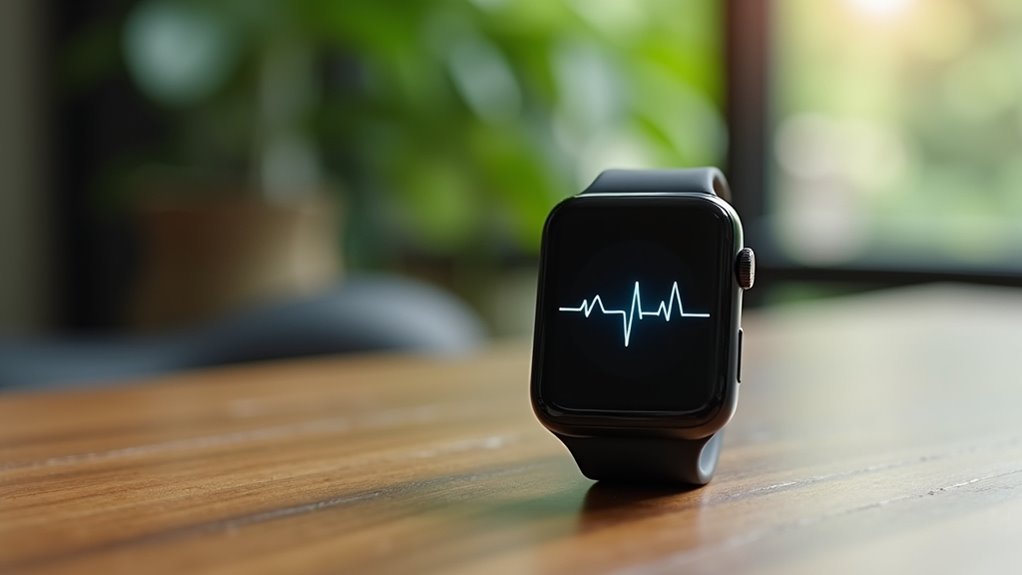
Heart rate variability (HRV) represents one of the most promising biomarkers for stress assessment available through wearable technology. When you’re stressed, your sympathetic nervous system activates, reducing the natural variation between heartbeats. Your wearable device detects these changes through photoplethysmography, measuring pulse intervals to calculate HRV in real-time.
Your wearable continuously monitors stress through heart rate variability, detecting sympathetic nervous system activation before you consciously feel overwhelmed.
You’ll notice decreased HRV during stressful periods, particularly in high-frequency components that reflect parasympathetic activity. This reduction often occurs before you consciously recognize stress symptoms, providing early warning signals.
Your device establishes personal baselines over time, making deviations more meaningful for tracking your stress patterns. As you recover from stress, HRV rebounds, allowing you to monitor your resilience and autonomic recovery. However, specialized equipment provides more accurate measurements than consumer wrist-worn fitness trackers, which generally lack the sensitivity required for precise HRV assessment.
This objective measurement complements your subjective feelings, offering valuable insights into your overall stress management and autonomic nervous system balance.
Breathing Pattern Detection and Respiratory Rate Analysis
Your respiratory patterns reveal essential information about your stress levels, with wearable devices now capable of detecting subtle changes in breathing rate, depth, and regularity that often precede conscious awareness of stress. These wearables integrate multiple sensors in chest attachments or smart fabric T-shirts, processing signals in real-time to provide immediate feedback.
| Monitoring Technology | Key Features |
|---|---|
| Wearable Sensors | Real-time breathing rate detection |
| Smart Fabric Integration | Comfortable, extended-wear monitoring |
| App-Based Analysis | Pattern variability assessment |
| Audio Biofeedback | Music-guided breathing regulation |
| Signal Processing | Low-pass filtering for accuracy |
You’ll receive personalized feedback through visual, audio, and haptic modalities that guide you toward slower, more regular breathing patterns. This monitoring promotes stress reduction while enhancing cardiovascular benefits and mindfulness training effectiveness. Unlike traditional approaches, these wearable systems offer non-invasive monitoring that can potentially reduce dependence on medication-based stress management interventions.
Galvanic Skin Response Sensors for Emotional Arousal Tracking
Your body’s sweat glands respond instantly to emotional changes, and GSR sensors capture this physiological shift by measuring how electrical conductivity varies across your skin.
These wearable devices detect the microscopic moisture changes that occur when your sympathetic nervous system activates during stress, excitement, or anxiety. Advanced units like the Shimmer3 GSR+ feature four digitally controlled measurement ranges that enhance accuracy across different conductivity levels.
You’ll get real-time feedback about your emotional arousal intensity, though the sensors can’t distinguish whether you’re experiencing positive excitement or negative stress without additional context.
GSR Technology Fundamentals
Electrodes serve as the foundation of GSR technology, transforming subtle changes in your skin’s electrical conductance into measurable data that reveals emotional arousal. Ag/AgCl electrodes deliver accurate signal transmission while maintaining safety standards, making them the preferred choice for GSR measurements.
The system works by applying constant low voltage across two electrodes, typically placed on your fingers or palms where sweat glands are concentrated. When you experience arousal—whether psychological or physiological—increased sweat gland activity changes your skin’s conductance. These changes travel through electrodes and wires to your device, which samples the data at 1-32 Hz rates.
Modern GSR sensors offer wireless connectivity and battery operation, enabling comfortable wearable solutions that require minimal setup compared to invasive biofeedback methods like fMRI or EEG. This unconscious behavior measurement capability makes GSR particularly valuable since emotional sweating occurs through automatic autonomic nervous system responses that aren’t under cognitive control.
Real-Time Stress Detection
When stress strikes, your GSR sensor immediately detects the physiological changes through rapid shifts in skin conductance, transforming your body’s electrical responses into actionable data within seconds.
Machine learning algorithms analyze these signals alongside heart rate variability to predict your stress levels before you’re consciously aware of them.
Your wearable device continuously monitors these physiological patterns, enabling timely interventions when stress escalates. The technology tailors personalized management strategies based on your unique stress responses, since everyone’s physiological reactions differ markedly.
However, real-world detection faces challenges from contextual variability and data quality issues. Algorithmic complexity requires robust models to handle individual differences accurately. Environmental factors like temperature and pressure can also influence your stress readings and affect detection accuracy.
Despite these limitations, continuous monitoring enhances early detection capabilities, allowing you to proactively manage stress and prevent related health complications through immediate alerts.
Machine Learning Algorithms for Real-Time Stress Detection
As wearable devices become more sophisticated, machine learning algorithms have emerged as the cornerstone technology enabling real-time stress detection from physiological signals. You’ll find Support Vector Machines (SVM) and logistic regression models leading the charge, classifying stress states from your heart rate variability, electrodermal activity, and respiration patterns.
Decision trees, random forests, and deep learning neural networks capture complex nonlinear stress patterns that simpler models might miss.
However, you’ll face significant challenges when implementing these algorithms. Individual physiological responses vary greatly, requiring personalized model calibration. Motion artifacts and noise complicate data accuracy, while obtaining sufficient labeled training data in real-world settings remains difficult.
The key lies in balancing computational complexity with your device’s processing constraints while ensuring reliable, real-time performance. Machine learning offers significant advantages over traditional methods by analyzing complex data patterns that conventional interviews and questionnaires might overlook due to their static nature.
Popular Consumer Devices and Their Stress Monitoring Features
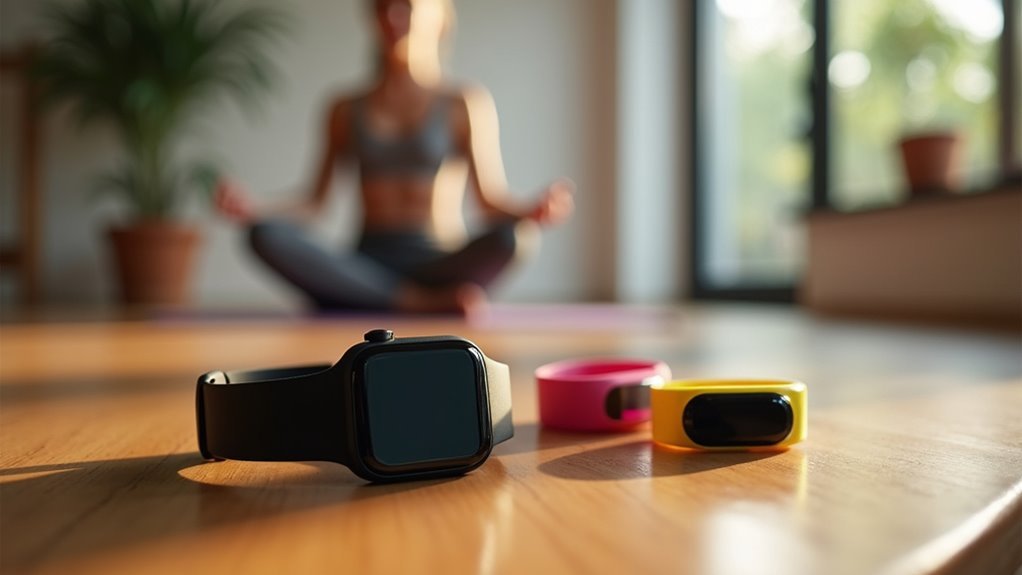
While machine learning algorithms provide the computational foundation for stress detection, the consumer market now offers diverse wearable devices that translate these technologies into practical stress monitoring solutions.
You’ll find the Oura Ring 4 leading with advanced biometric tracking across 30+ health metrics, while Google Fitbit delivers stress management scores through heart rate and sleep analysis.
Whoop 4.0 excels in thorough recovery tracking, and the Muse S Headband uses EEG technology to monitor brain activity directly.
For active intervention, Apollo Neuro employs vibration therapy to improve your HRV and reduce stress levels. These emerging technologies represent part of a broader surge in at-home neurofeedback popularity as consumers seek non-invasive, drug-free solutions for managing mental well-being.
These devices utilize key features like electrodermal activity monitoring, passive tracking capabilities, and seamless app integration, though you’ll encounter varying accuracy levels and battery life concerns across different models.
Multi-Sensor Data Integration for Enhanced Accuracy
You’ll get more accurate stress readings when your wearable combines multiple biosignals like heart rate variability, skin conductance, and body temperature rather than relying on just one metric.
These devices use machine learning algorithms to analyze patterns across all sensors simultaneously, filtering out noise and identifying true stress indicators.
This multi-sensor approach helps distinguish between stress and other activities that might trigger similar physiological responses, like exercise or caffeine consumption. The integration of remote sensor technologies represents a significant advancement in preventive healthcare, enabling continuous health monitoring beyond traditional clinical settings.
Combining Multiple Biosignals
Modern stress detection requires more than monitoring a single physiological signal—combining multiple biosignals dramatically improves accuracy and reliability in wearable devices.
When you wear a multi-sensor device that tracks both electrodermal activity (EDA) and heart rate variability (HRV), you’ll achieve around 95% accuracy in stress detection compared to single-signal monitoring.
Your device can simultaneously capture respiratory patterns, brain activity through EEG, and additional metrics like body temperature and muscle activity for thorough assessment.
This multi-sensor approach reduces false positives you’d encounter with single biosignals while providing stronger correlation with validated stress biomarkers like salivary cortisol (R²=0.714).
You’ll receive more reliable real-time feedback since the system leverages complementary data streams, creating a holistic stress profile that accounts for individual variability in physiological responses.
These devices can be worn on various body parts including your wrist, waist, or directly on your skin, with some models designed to integrate seamlessly into your clothing attachments.
Machine Learning Algorithms
Machine learning algorithms transform raw multi-sensor data into actionable stress insights by processing complex physiological patterns that would overwhelm traditional analysis methods.
When you’re wearing a device that captures heart rate, motion, and other bio-signals simultaneously, these algorithms integrate everything into thorough stress assessments you can actually use.
You’ll get personalized feedback that adapts to your specific physiological responses over time. The algorithms learn your baseline patterns and detect deviations that signal stress before you’re even aware of them.
Real-world testing verifies these systems work accurately outside controlled lab environments, accounting for your daily activities and environmental factors. These systems also monitor skin conductance patterns alongside other biometric indicators to provide comprehensive physiological assessments.
Cross-validation techniques maintain reliability while performance metrics like accuracy and precision guarantee you’re receiving trustworthy stress insights for immediate action.
Real-Time Biofeedback and Intervention Prompts
When stress begins to spike, biofeedback wearables don’t just passively collect data—they actively intervene with real-time feedback and personalized prompts designed to help you regain control.
These devices monitor your heart rate variability, breathing patterns, and emotional state through sensors that detect physiological changes instantly. When elevated stress levels are detected, your wearable provides immediate coaching through audible and visual cues, guiding you through targeted breathing exercises or relaxation techniques.
The technology creates customized stress assessments based on your individual baseline measurements, ensuring interventions match your specific needs.
Whether you’re in a high-pressure profession or managing daily anxiety, these real-time prompts help you develop essential self-regulation skills, activating your parasympathetic nervous system for immediate stress relief. Since biofeedback is not a standalone treatment, these wearable devices work best when combined with other wellness strategies and professional healthcare guidance.
Physiological Benefits of Continuous Stress Monitoring
When you wear continuous stress monitoring devices, you’re actively supporting your autonomic nervous system’s ability to maintain ideal balance between sympathetic and parasympathetic responses.
You’ll receive real-time intervention prompts that allow you to address stress spikes immediately, preventing the cascade of physiological changes that lead to chronic health issues.
This constant feedback loop enhances your self-awareness, helping you recognize stress patterns and triggers before they escalate into more serious cardiovascular or mental health problems. These devices utilize cortisol biomarkers measurable through non-invasive methods like sweat analysis to provide accurate physiological stress data.
Autonomic Nervous System Regulation
Because your autonomic nervous system operates automatically without conscious control, continuous stress monitoring through biofeedback wearables provides unprecedented insight into your body’s real-time physiological responses.
These devices track when your sympathetic nervous system triggers fight-or-flight reactions, elevating heart rate and respiration even when no real danger exists. You’ll receive immediate alerts about inappropriate stress activation, allowing you to implement deep breathing techniques that activate your parasympathetic nervous system for calming effects.
This real-time feedback improves your ability to maintain emotional stability and develop appropriate stress responses. Developing stronger interoceptive pathways through continuous monitoring enhances your capacity to recognize subtle bodily sensations before they escalate into full stress responses.
You’ll build resilience to daily stressors while preventing chronic anxiety patterns. Enhanced regulation means you’ll recover from acute stress episodes faster, creating a balanced autonomic nervous system that supports overall well-being.
Real-Time Stress Intervention
Real-time stress intervention through continuous physiological monitoring transforms how you manage stress by detecting elevated responses within seconds of their onset.
Your wearable device tracks heart rate variability, skin conductance, and temperature, triggering immediate alerts when stress markers spike. This proactive approach prevents chronic stress accumulation that often leads to cardiovascular problems, headaches, and sleep disturbances.
You’ll receive personalized recommendations like deep breathing exercises or brief walks based on your current physiological state. The system adapts to your unique patterns, factoring in physical activity and time of day for accurate detection. Advanced machine learning approaches continuously refine prediction accuracy by analyzing your historical physiological data patterns.
Enhanced Self-Awareness Development
Self-awareness becomes dramatically enhanced when continuous physiological monitoring reveals the subtle bodily changes that precede conscious stress recognition. Your wearable biosensor tracks heart rate, respiratory patterns, skin temperature, and cortisol levels, establishing your unique baseline patterns.
You’ll recognize stress triggers before they escalate into full emotional responses. This physiological feedback correlates internal bodily signals with external events, creating personalized stress profiles.
You’ll discover how stress affects your concentration, decision-making, and emotional reactivity throughout daily activities. Heart rate variability monitoring provides insights into your autonomic nervous system balance, helping you understand sympathetic and parasympathetic activities. Healthcare professionals traditionally use electrocardiograms to assess these cardiovascular patterns, but personal wearables now make this technology accessible for everyday stress tracking.
Your enhanced metacognition develops as objective biomarker data couples with self-reported feelings across different contexts. This data-driven awareness eliminates subjective bias, fostering emotional intelligence growth and supporting proactive mental health management through measurable physiological insights.
Advanced Neurofeedback Technology in Wearable Devices
While traditional stress monitoring relies on heart rate and skin conductance, neurofeedback wearables take you deeper into your body’s stress response by directly measuring brain activity. These devices primarily use EEG technology to track brainwave patterns, including gamma waves that indicate cognitive stress levels.
Some advanced models employ hemoecephalography (HEG), which measures oxygenated blood flow in your brain rather than electrical activity.
You’ll find devices equipped with conductive polymer sensors that enhance comfort while maintaining measurement precision. Many wearables integrate multiple sensors, combining EEG with EMG to capture both brain and muscle activity. Modern devices typically utilize dry electrodes that eliminate the need for conductive gels while maintaining medical-grade signal quality.
Advanced models incorporate inertial measurement units for thorough biomechanical feedback.
The real-time data translates into interactive feedback through gaming interfaces, audio cues, or haptic signals, allowing you to visualize and actively modify your stress response patterns.
Performance Optimization Through Stress Pattern Recognition
Beyond monitoring your brain’s electrical patterns, modern wearables excel at identifying your unique stress signatures to enhance performance across various activities.
Your device analyzes physiological markers like heart rate variability, electrodermal activity, and galvanic skin response to detect stress patterns before they impact your performance.
Your wearable detects stress signals through heart rate variability and skin response before performance drops occur.
Machine learning algorithms including K-Nearest Neighbors, Fuzzy Logic, and Support Vector Machines process this data with remarkable accuracy.
Your smartwatch or fitness band continuously monitors these signals, creating a personalized stress profile that reveals when you’re approaching your ideal performance zone versus when stress begins degrading your abilities. Studies show that PPG sensors in wrist-worn devices can effectively detect significant variations in heart rate and respiratory rate during stress-inducing situations.
This real-time analysis enables early intervention, preventing psychological and physical health issues while maintaining peak performance levels across training sessions and daily activities.
Frequently Asked Questions
How Long Does the Battery Last on Most Stress Monitoring Wearables?
You’ll find stress monitoring wearables’ battery life varies widely. Screenless bands like Whoop last 14 days, smartwatches range from 1-11 days, while smart rings offer longer life than most watches.
Can Stress Tracking Wearables Be Worn While Swimming or Showering?
You can wear most stress tracking wearables while swimming and showering since they’re typically waterproof. However, heart rate and stress sensors may lose accuracy underwater due to reduced skin contact.
Do Biofeedback Wearables Work Accurately for People With Heart Conditions?
You’ll find biofeedback wearables generally work accurately for heart conditions, but you should consult your doctor first. Some devices have limitations with specific cardiac conditions, though they’re useful for continuous monitoring and stress tracking.
How Much Do Professional-Grade Stress Monitoring Wearables Typically Cost?
Professional-grade stress monitoring wearables typically cost between $179-$349, like the FitVII GT5 Pro or Oura Ring 4. You’ll also face monthly subscription fees of $5.99 for full functionality on premium devices.
Are There Any Side Effects From Wearing Stress Tracking Devices Daily?
You won’t experience documented physical side effects from daily stress tracking device use since they’re noninvasive. However, you might develop psychological stress from overrelying on device feedback for decision-making.


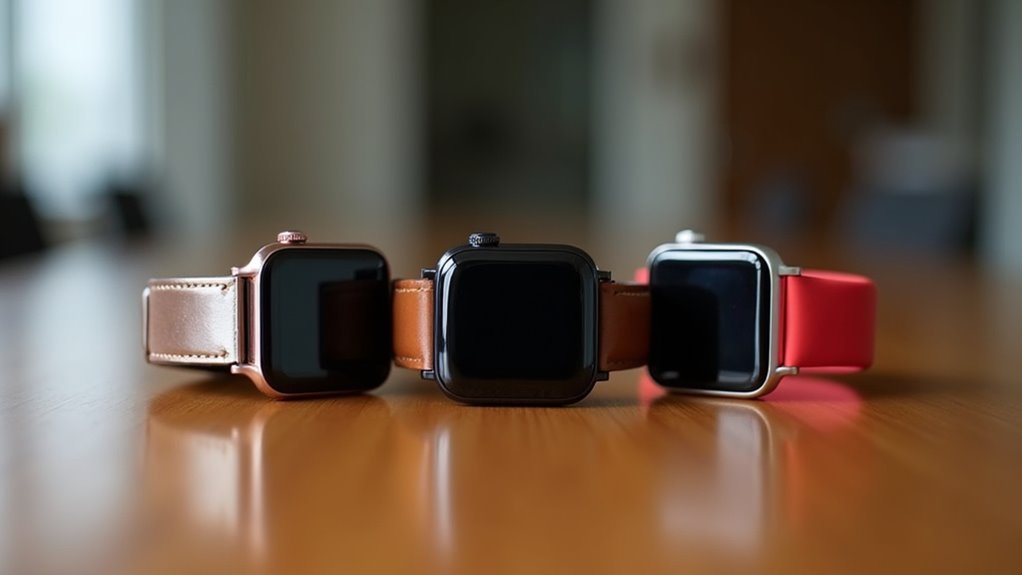
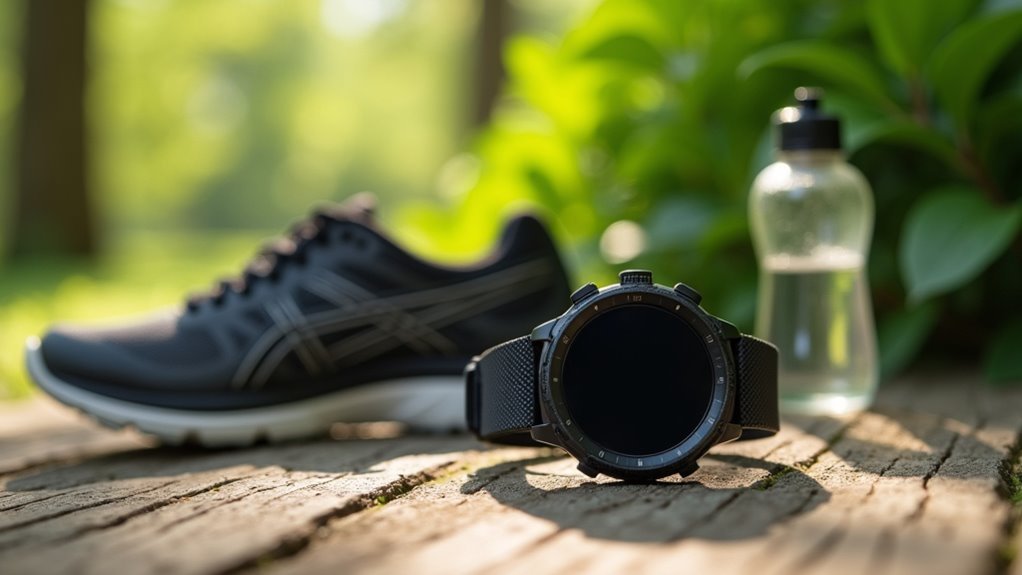
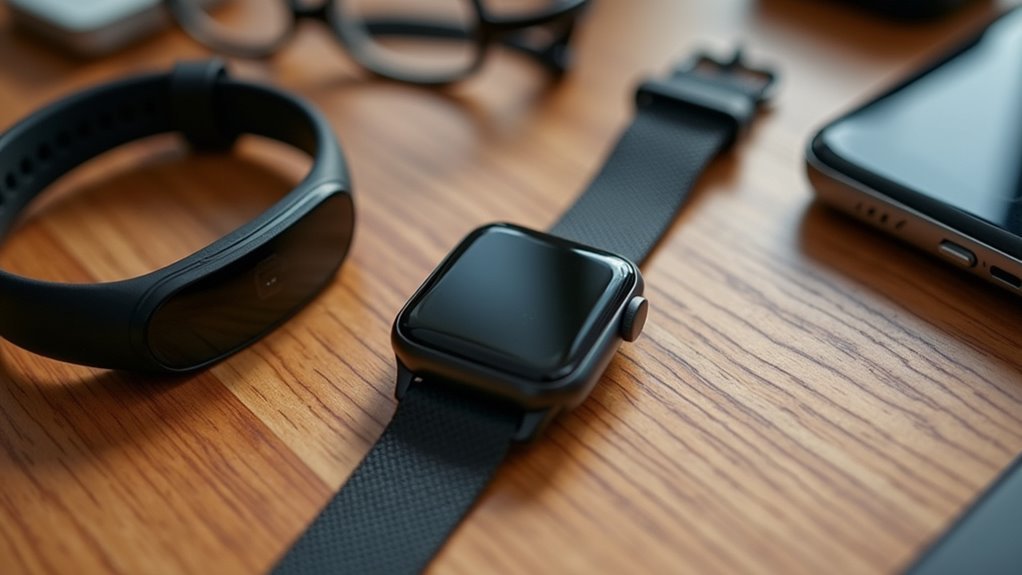
Leave a Reply